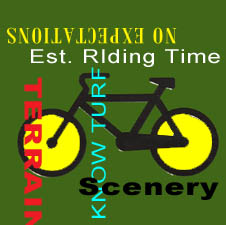| Structuring Your Cycling |

SEACOAST CYCLING #4
Who said cyclists never plan? The Great Balkini does, and in this installment he tells you how to ride smarter, not harder. Sure you like to just hop on and ride into the great blue yonder, but think about it. Could you, perhaps, get more out of that trip with a few special tips?
About the Great Balkini
Paved roads are everywhere and everyone thinks they know how to ride a bike. That sounds cool, but cyclists really need a game plan. As with golf, tennis and almost any other adult recreational activity, participants should know exactly where and how to play and for how long.
Structure brings comfort and that is especially true for anyone with developing skills. While runners share the same stage and lack of boundaries with cyclists, their jarring effort creates structure. Not even idiots run until they get really tired then turn around and run back.
Cyclists are different. We start off invincible, suspended on super-efficient machinery that tames gravity and redefines distance. Unprepared riders make heroic efforts and rise to unrealistic challenges. Be careful what you wish for. For the overachiever, a heroic bike ride can be a devastating experience.
Even for the prepared, not knowing how long a ride is going to take and what’s up the road can make riding far more difficult. Uncertainty interrupts concentration. Questions affect every pedal stroke and magnify every ache. Do that for a dozen miles too many and you have torture. That takes a long term mental toll. For every rider who comes back for more, scores put the bike away.
Nobody except cyclists buy sporting goods equipment if they do not know exactly where they are playing. That is a big mistake. Before starting a riding program, make the effort to drive all the roads intended. Then lay out a course or two with a really easy starter loop that can be as short as around the block. Less brings you back for more.
The goal is a 5 star road course offering a lack of high-speed traffic, predictable riding time, forgiving terrain, spectacular scenery, and smooth tarmac. Courses with all these attributes are well worth a trip in the car. A bonus star goes to any course that you can reach right out your back door for an hour or two easy ride.
Ride by ride, learning every inch of a road is by no means boring; it offers a chance to measure progress as well as a home court advantage. Knowing the terrain, the prevailing winds and when to "turn it on" creates Newton in action. Bodies in motion really do stay in motion. Good cyclists harness momentum to roll over terrain that casual riders regard as hilly. This is technique not strength. Learning the roads and thinking ahead turns a diet of exercise into a feast.
Our seacoast region is laced with sparsely populated roads that meet all the above criteria and are well worth driving to. Paralleling the Atlantic, there are loops only a mile or two inland, with hundreds of miles of rural two lane roads that go nowhere special as their meanderings were first laid out by glaciers with no particular agenda. A few jillion years later came settlers with horse and buggy following this hardscrabble path in search of the least resistance. With the advent of the Model T these wandering buggy paths got widened a bit and paved.
By today’s standards, replete with frost heaves and patches of broken tarmac, they’re just not good enough. They twist and turn over small hills making them the long, bumpy way to everywhere except to small farms dotting the landscape and the single family homes hiding in the woods.
With the advent of the interstate highway system old roads that go nowhere are not exclusive to the Seacoast; they’re everywhere. While these back roads do not have shoulders or room for bike lanes, the traffic is slower and by default these are the bike paths of the 21st century. Forget about dedicated bike lanes. They’re pie in the sky with little need and no money to build them. It’s an automobile world and they’re never going to happen. To be a successful rider you need a venue so explore your neighborhood and create a course or two.
The final bit of structure involves your expectations. Other than fun, don’t have any. Knowing the roads is the first giant step to becoming a good cyclist while knowing yourself is a work in progress. Meanwhile, be confident that patience equals gain and pain in the pursuit of fun is sophomoric.
Above all, don’t struggle or pout if you can’t keep up with some old, fat slob effortlessly riding by. Bike life is best practiced on cruise control where every pedal stroke turns your mountain into a molehill.
Copyright (c) 2005 by David Balkin. All rights reserved.
